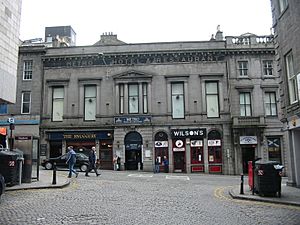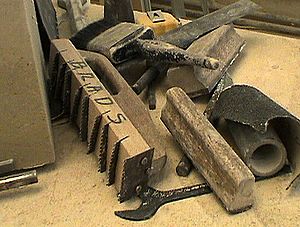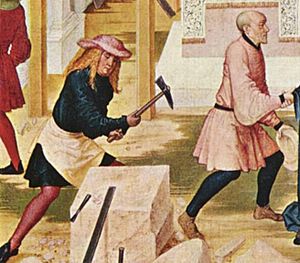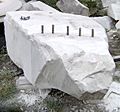Stonemasonry facts for kids
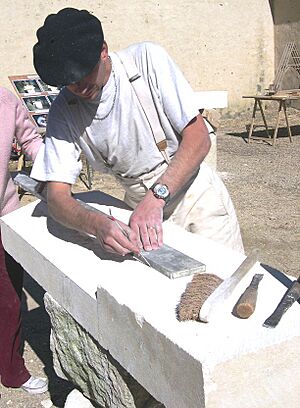
Stonemasonry is an ancient skill where people shape and build things using stone. People who do this work are called stonemasons. They have been around since the very beginning of civilization!
Stonemasons have built many amazing and long-lasting buildings and structures from stone found in the earth. Think of famous monuments like the Egyptian pyramids, the Greek Parthenon, and even Stonehenge. These incredible structures show how important stonemasons have been throughout history in many different cultures.
Contents
What is Stonemasonry?
Stonemasonry is the craft of taking rough pieces of rock and shaping them into exact forms. These shapes can be simple or very complex. Stonemasons then arrange these shaped stones, often using a special glue called mortar, to create strong structures.
Different Types of Stonemasons
There are several types of stonemasons, each with a special job:
- Quarrymen are the ones who find and split large sheets of rock. They carefully take these big blocks of stone out of the ground.
- Sawyers cut these rough blocks into smaller, exact sizes using saws with diamond tips. If a block is cut on all six sides for a specific part of a building, it's called "sawn six sides" (SSS).
- Banker masons work in a workshop. They shape the stones according to the building's design, using templates. They can make anything from simple sloped edges (chamfers) to fancy window designs (tracery) and detailed decorations. When they work on a stone, they make sure it will sit in the building exactly as it was formed. The basic skills of a banker mason have been used for thousands of years.
- Carvers are like artists. They use their creative skills to carve stone into beautiful shapes. These can be leaves, figures, animals, or abstract designs.
- Fixer masons are experts at putting stones onto buildings. They use special lifting tools and traditional lime mortars. Sometimes, they use modern glues like epoxy resins for special jobs, such as attaching thin stone coverings (cladding). This job needs great skill because the stones must fit perfectly.
- Memorial masons or monumental masons create gravestones. They also carve the names and messages onto them.
Today, stonemasons get a lot of training, both in classrooms and on the job. They learn not only how to work with their hands but also about each type of stone. They know its best uses and how to properly work with it and fix it in place.
Types of Stone Used
Stonemasons use all kinds of natural stone. These include igneous, metamorphic, and sedimentary stones. Some also work with artificial stone.
Igneous Stones
- Granite is one of the hardest stones. Working with it is so different from softer stones that it's almost a separate skill. It's very strong and lasts a long time. Granite is often used for things like kerbstones, kitchen counters, flooring, and breakwaters.
- Igneous stones can range from very soft rocks like pumice to very hard ones like granite and basalt.
Metamorphic Stones
- Marble is a beautiful stone that is easy to work with. It comes in many colors, but white is the most common. It has been used for carving statues and decorating famous buildings for centuries. The ancient Greeks were amazing marble carvers. They used marble from islands like Paros and Thassos, and the bright white Pentelikon marble. The famous Acropolis of Athens was built using Pentelikon marble. Today, much of the world's marble comes from Carrara in Italy.
- Slate is a popular choice for memorials and carvings. Its fine texture and hardness mean that carved details look very sharp. Because it can split into thin layers, slate is also a common material for roofing.
Sedimentary Stones
Many famous buildings around the world are made from sedimentary stone. Examples include Durham Cathedral in England and St Peter's in Rome. The two main types of sedimentary stone used in masonry are limestones and sandstones. Some well-known limestones are Bath and Portland stone. Yorkstone and Sydney sandstone are common sandstones.
Different Ways to Build with Stone
There are several ways stonemasons build structures:
- Rubble masonry: This is when rough, uneven stones are laid together using mortar. The stones are not perfectly shaped.
- Ashlar masonry: This uses stones that have been carefully cut and shaped. These stones fit together very precisely.
- Stone veneer: This is a thin layer of stone used to cover walls, inside or out. It's usually about 1 inch (2.54 cm) thick and light enough not to need extra support. Thin, flat stones are glued with mortar onto the wall's surface.
- Slipform stonemasonry: This method uses temporary frames (forms) to help build stone walls. The forms, usually up to two feet tall, guide the stonework. Stones are placed inside the forms with their best sides facing out. Concrete is then poured behind the rocks. This creates a strong wall that is partly reinforced concrete and partly stonework.
Training to Become a Stonemason
In the past, medieval stonemasons learned their trade through a seven-year apprenticeship. A similar system is still used today.
A modern apprenticeship usually lasts three years. It combines learning on the job with experienced stonemasons and classroom studies. Apprentices learn about building, shaping stone, and the theory behind masonry. Some colleges offer courses that teach not only hands-on skills but also things like reading blueprints and conserving old buildings. Workshops are also a great way to learn.
To become a stonemason, you should be comfortable working at heights. You also need good hand-eye coordination and basic math skills. Being moderately fit is helpful too. Most of these skills can be developed while you are learning.
Tools of the Trade
Stonemasons use many different tools to handle and shape stone blocks and slabs. The main tools for shaping stone are a mallet, chisels, and a metal straight edge. With these, a mason can create a flat surface, which is the starting point for all stonemasonry.
Chisels come in many sizes and shapes. They are used for different jobs, like removing large amounts of stone or putting a fine finish on the surface.
Today, mortar is usually mixed using machines with rotating drums or paddles.
The masonry trowel is used to apply mortar between and around the stones as they are put in place. Filling the gaps (joints) with mortar is called pointing. Smaller joints can be filled using special pointing trowels.
A mason's hammer has a long, thin head and is called a Punch Hammer. It is used with a chisel or splitter for various tasks. A walling hammer can also be used to create rough stone pieces.
Stonemasons use a lewis with a crane or block and tackle to lift heavy building stones into position.
Today, power tools like compressed-air chisels, abrasive grinders, and angle grinders are often used. These tools save time and money, but they still require skill and careful handling. However, many basic stonemasonry tools, like chisels, have stayed almost the same for thousands of years. Chisels found at the Egyptian pyramids are very similar to those you can buy today!
History of Stonemasonry
Stonemasonry is one of the oldest jobs in human civilization. During the Neolithic Revolution, when people started farming and taming animals, they also learned to use fire to make quicklime, plasters, and mortars. They used these to build homes from mud, straw, or stone, and that's how masonry began.
Ancient civilizations relied heavily on stonemasons to build their most impressive and long-lasting monuments. The Egyptians built their pyramids, the civilizations of Central America built their step pyramids, the Persians built their palaces, the Greeks built their temples, and the Romans built their public works and wonders. Cities like Dholavira in the Indus Valley Civilization were known for their stone buildings. Sophroniscus, the father of the famous philosopher Socrates, was a stone-cutter.
Building castles was a huge industry for medieval stonemasons. After the Western Roman Empire fell, building with cut stone became less common in much of Western Europe. More buildings were made from timber. But stone work became popular again in the 9th and 10th centuries. By the 12th century, a strong religious feeling led to thousands of amazing churches and cathedrals being built from stone across Western Europe.
Medieval stonemasons were in high demand. They were part of a guild and had three levels: apprentices, journeymen, and master masons. Apprentices learned from their masters. Journeymen were skilled workers paid by the day. Master masons were considered free and could travel to work on projects for different patrons. They could also train apprentices. During the Renaissance, the stonemason's guild started letting in people who weren't stonemasons. Eventually, it became the Society of Freemasonry, which are groups that follow the traditions of stonemasons but don't usually build things anymore.
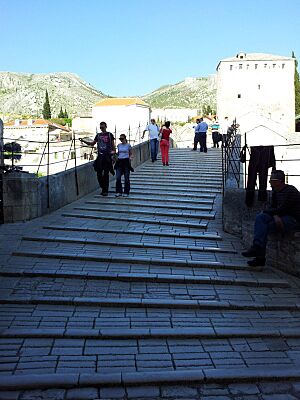
A medieval stonemason would often carve a personal symbol onto their stone block. This helped show whose work was whose and also helped check the quality of the work.
The Renaissance brought stonemasonry back to the amazing level of the Classical age. The new ideas of humanism inspired people to create incredible works of art. Italy became the center of the Renaissance. Italian city-states like Florence built great structures, including the Florence Cathedral, the Fountain of Neptune, and the Laurentian Library. The famous sculptor Michelangelo Buonarroti planned and built the Laurentian Library.
When Europeans came to the Americas, they brought their stonemasonry skills with them. They used the stone available in different areas. At first, buildings looked like those in Europe, but later, unique American architecture developed.
In the 20th century, stonemasonry changed a lot. Before then, most heavy work was done by animals or people. But with the invention of the internal combustion engine, many hard parts of the job became easier. Cranes and forklifts made moving and laying heavy stones much simpler. Motor-powered mortar mixers saved a lot of time and energy. Compressed-air tools made working with stone faster. Petrol and electric-powered abrasive saws can cut stone much quicker and more accurately than chisels alone. Also, Carbide-tipped chisels are much stronger than the old steel and iron chisels made by blacksmiths.
Gallery
-
Three different stonemason's marks, which can be seen in the Chapter House of Fountains Abbey
-
A modern stonemason's workbench with a block of limestone
-
Typical French chisels with wooden hilt, used for soft limestone
-
Splitting a block of marble with plug and feathers
See also
 In Spanish: Cantería para niños
In Spanish: Cantería para niños


